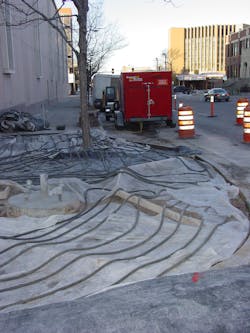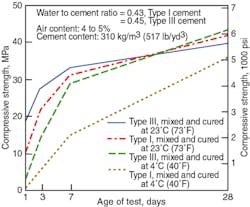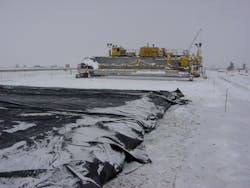Controlling concrete placing and curing temperatures is the key to success
There are three primary objectives for cold weather concreting: 1) Protect the newly placed concrete from damage due to early-age freezing; 2) Maintain curing conditions to ensure adequate strength gain; and 3) Protect concrete from thermal shock and related cracking at the end of the protection period.
If freshly placed concrete freezes, immediate and permanent damage may occur. Damage occurs because water (i.e., batch or mixing water) expands 9% in volume when it freezes. The formation of ice crystals and lenses, resulting paste expansion, and microcracking can reduce the compressive strength and increase the porosity of the hardened concrete (Figure 1). Strength reductions up to 50% can occur if freezing takes place in the first few hours after placement or before the concrete attains a compressive strength of approximately 500 psi. Subsequent curing will not heal the damage and restore the concrete’s hardened properties.
Freshly placed concrete must be protected from early-age freezing until the amount of mixing water or the degree of saturation has been sufficiently reduced by the process of hydration, which describes the chemical reaction between the portland cement or cementitious materials and water. During hydration, the degree of saturation of the concrete mixture continually decreases as the mixing water combines with the cementitious materials and the mixture begins to stiffen and harden. Due to the hydration process, the amount of available mixing water to form ice crystals and lenses decreases, so there is less risk of permanent damage if the concrete freezes.
When there are no external sources of water, the critical degree of saturation—so that a single cycle of freezing does not permanently damage the concrete—occurs when the concrete attains a strength of at least 500 psi. At specified concrete curing temperatures, well-proportioned concrete mixtures should obtain this strength within about 24 hours. For cement-rich mixtures or mixtures with hot water and chemical accelerators, 500 psi strength may be attained much sooner. Therefore, it is critical that freshly placed concrete be protected from freezing for the first 24 hours or until the concrete attains a strength of at least 500 psi.
When concrete attains a strength of at least 500 psi, it can tolerate one freeze-thaw cycle without damage if the concrete is air-entrained and not exposed to an external water source. For exposures to repeated cycles of freezing and thawing, new concrete should attain a minimum in-place strength of at least 3,500 psi if exposed to repeated cycles of freezing and thawing and 4,500 psi if exposed to deicing chemicals as well. Also, newly placed concrete, or more specifically the mixing water within the concrete pores, does not freeze until the temperature drops below 32°F due to alkalies within the pore water and other factors. Therefore, do not panic and assume the concrete froze if the measured concrete temperature is 32°F or a few degrees less. To avoid early-age, permanent damage from cold weather, protect the concrete from freezing as soon as possible after placing, consolidating, and finishing.
Protect to Ensure Adequate Strength Gain
The rate of concrete hardening and strength gain depends on the temperature of the concrete. As shown in Figure 2, low concrete cure temperatures decrease the rate of hydration and subsequently retard the rate of strength gain. To ensure newly placed concrete develops the required strength for safe removal of forms, shores, and reshores, and safe loading of structures during and after construction, adequate concrete temperatures must be maintained during the protection or curing period.
Concrete Placing and Curing Temperature: All surfaces to receive fresh concrete should be free of snow, ice, and standing water. Do not place fresh concrete on frozen bases or subgrades. Avoid temperature differences exceeding about 20°F between the fresh concrete and base material for slabs on ground; otherwise, inconsistent setting, rapid moisture loss, delaminations, and plastic shrinkage cracking may occur.
Typically, cold weather concreting specifications set minimum concrete placing temperatures, minimum concrete cure temperatures, and cure periods to protect the concrete from both early-age freezing and to ensure adequate strength gain. The most common minimum concrete placing and concrete curing temperatures specified by DOTs are 50°F and 55°F, but a few are as low as 40°F. Some DOTs have decreasing or step-down minimum concrete cure temperatures based on time.
Most inspectors will measure the fresh concrete temperature at the point of delivery or placing location. However, some may measure the concrete after placement or in the forms. For some DOTs, only the minimum concrete placing temperatures are specified. Instead of specifying minimum cure temperatures, these DOTs specify the minimum required insulation (R-value) or heated enclosure temperatures based on the minimum section dimension and ambient air temperatures. While different, each DOT has specifications to start curing immediately after finishing to maintain temperatures of the newly placed concrete to protect against early-age freezing and to ensure adequate strength gain. On your next job, be sure to know the minimum concrete placing and curing temperatures; also, be sure to allow for concrete temperature drop during delivery.
Protection Periods: DOTs specify the curing time period differently. Some require minimum time periods with a minimum cure temperature while others base the minimum cure period upon compressive or flexural strength primarily determined by the maturity method. Concrete maturity is an indirect means to estimate in-place concrete strength by combining temperatures and time (Figure 3).
Some DOTs require a minimum cure period of 5, 7, or 14 days with a specified minimum cure temperature for different types of structural elements, while others base the length of the cure period on gained concrete strength as determined by the maturity method. For example, DOTs often require the contractor to maintain the temperature of pavements at or above 40°F until the concrete has attained an in-place compressive strength of at least 2,000 psi, or specify the minimum cure period shall be from the time of concrete placement until the concrete has met a specified percentage of the required strength. If allowed, always use the maturity method to estimate in-place strength because it is typically the safest and most economical means.
Protection Methods: Insulation or winter curing blankets are the most economical means of maintaining adequate concrete cure temperatures because this method takes advantage of the heat of hydration, or the heat generated by the chemical reaction between the cementitious materials and water (Figure 4). Depending on the mass of the concrete, cementitious materials content, concrete temperature, and ambient conditions, insulation can typically maintain adequate cure temperatures.
Cover the concrete with blankets as soon as possible without marring the surface to capture as much of the heat of hydration as possible. Capturing the early heat will help maintain the cure temperature but will also help promote hydration, which in turn produces additional heat. Be sure to protect edges, corners, and surfaces, since these areas are the most susceptible to early-age freezing and damage. Be sure to overlap and secure blankets so that wind and passing trucks do not blow them off the concrete.
For extreme winter conditions, sometimes the heat of hydration is not sufficient to maintain adequate cure temperatures and supplementary heat is required. Additional heat can be supplied using electric heated concrete blankets, hydronic heaters with winter curing blankets, and heated enclosures. Of course, using supplementary heat can significantly increase the cost of cold weather concrete curing.
Protection from Thermal Shock and Cracking
At the end of the protection period, gradually remove insulation or other protection so the surface temperatures cool gradually during the subsequent 24-hour period. Otherwise, the surface of the concrete may cool too quickly, creating large thermal gradients between the surface and interior portions of the concrete, and the resulting thermal stresses can cause random surface cracking. Essentially, the surface of the concrete is thermally shrinking, but the interior portion is still warm and not shrinking, so the surface cracks. Consider slowly reducing sources of heat or leaving insulation in place until concrete temperatures cool to match the average air temperatures. Some contractors remove protection during the day when temperatures are warmer and replace at night when temperatures drop; however, this is a costly approach with regards to labor.
Specifications typically limit the maximum surface temperature drop to 50°F in a 24-hour period. However, your specifications may be different (less than 50°F) or based on the minimum dimension of the concrete section, so check for the maximum surface temperature drop allowed after removal of protection.
Preplanning is the key to successful cold weather concreting. When developing or implementing your next cold weather concrete curing plan, consider the three primary objectives: protect the concrete from early-age freezing, protect to ensure adequate strength gain, and protect from thermal shock and cracking.




